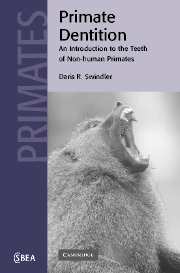Appendix 2 - Dental eruption sequences
Published online by Cambridge University Press: 05 October 2009
Summary
Dental eruption sequences are important indicators of life history patterns, are relatively robust to environmental disturbances, are useful for aging individuals, and have proved valuable in paleontological studies. In fact, Aristotle himself knew that tooth eruption could be used to estimate the age of an animal (Smith et al., 1994). Smith et al. (1994) said it most succinctly when they wrote ‘that teeth are a linchpin between the present and the past.’ The paper by Smith et al. (1994) is the most thorough compendium so far available on the ages of dental eruption in extant primates.
The dental eruption sequences of permanent teeth presented here include data from prosimians to the great apes and represents the work of many individuals for many years. With respect to tooth eruption, the first permanent tooth to erupt in all primates is the first molar; however, after that, the sequences differ among the taxa in various ways as seen in the data presented here. For example, the last tooth to erupt is extremely variable; it may be the third molar, a canine or even a premolar.
Sources: Harvati, 2000 (colobines); Schultz, 1935 (Hylobates and Pongo); Smith et al. 1994 (prosimians, cercopithecines, platyrrhines, Pan and Gorilla). Definitions, as used by Harvati (2000): brackets indicate any sequence polymorphism; the equal sign (=) between two teeth indicates that the two alternative sequences can occur an equal number of times; and the question mark indicates no data for that position.
- Type
- Chapter
- Information
- Primate DentitionAn Introduction to the Teeth of Non-human Primates, pp. 270 - 273Publisher: Cambridge University PressPrint publication year: 2002

